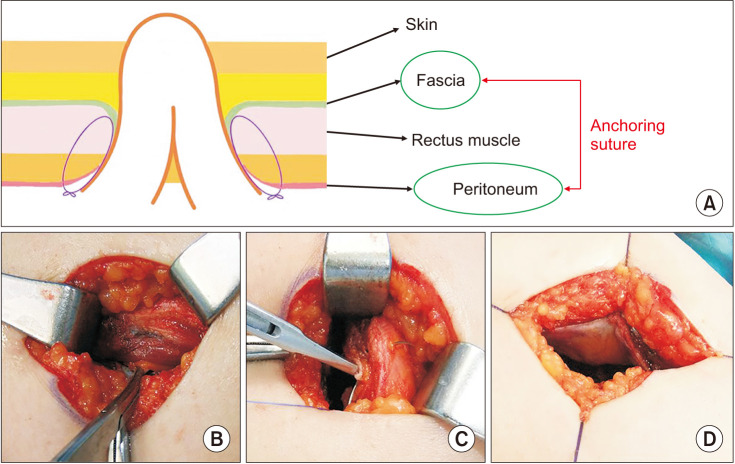Ann Surg Treat Res.
2021 Oct;101(4):214-220. 10.4174/astr.2021.101.4.214.
Effects of anchoring sutures at diverting ileostomy after rectal cancer surgery on peritoneal adhesion at following ileostomy reversal
- Affiliations
-
- 1Department of Nursing, Asan Medical Center, Seoul, Korea
- 2Division of Colon and Rectal Surgery, Department of Surgery, Asan Medical Center, University of Ulsan College of Medicine, Seoul, Korea
- KMID: 2520652
- DOI: http://doi.org/10.4174/astr.2021.101.4.214
Abstract
- Purpose
During diverting ileostomy reversal for rectal cancer patients who underwent previous sphincter-saving surgery, the extent of adhesion formation around the ileostomy site affects operative and postoperative outcomes. Anchoring sutures placed at the time of the ileostomy procedure may reduce adhesions around the ileostomy. This study aimed to evaluate the effects of anchoring sutures on the degree of adhesion formation and the postoperative course at the time of ileostomy reversal.
Methods
Patients who underwent sphincter-saving surgery with diverting ileostomy for rectal cancer between January 2013 and December 2017 were enrolled. Variables including the peritoneal adhesion index (PAI) score, operation time, the length of resected small bowel, operative complications, and postoperative hospital stay were collected prospectively and compared between the anchoring group (AG) and non-anchoring group (NAG).
Results
A total of 90 patients were included in this study, with 60 and 30 patients in the AG and NAG, respectively. The AG had shorter mean operation time (46.88 ± 16.37 minutes vs. 61.53 ± 19.36 minutes, P = 0.001) and lower mean PAI score (3.02 ± 2.53 vs. 5.80 ± 2.60, P = 0.001), compared with the NAG. There was no significant difference in the incidence of postoperative complications between the AG and NAG (5.0% vs. 13.3%, respectively; P = 0.240).
Conclusion
Anchoring sutures at the formation of a diverting ileostomy could decrease the adhesion score and operation time at ileostomy reversal, thus may be effective in improving perioperative outcomes.
Figure
Reference
-
1. Parker MC, Wilson MS, van Goor H, Moran BJ, Jeekel J, Duron JJ, et al. Adhesions and colorectal surgery: call for action. Colorectal Dis. 2007; 9 Suppl 2:66–72. PMID: 17824973.2. Menzies D, Ellis H. Intestinal obstruction from adhesions: how big is the problem? Ann R Coll Surg Engl. 1990; 72:60–63. PMID: 2301905.3. Cohen Z, Senagore AJ, Dayton MT, Koruda MJ, Beck DE, Wolff BG, et al. Prevention of postoperative abdominal adhesions by a novel, glycerol/sodium hyaluronate/carboxymethylcellulose-based bioresorbable membrane: a prospective, randomized, evaluator-blinded multicenter study. Dis Colon Rectum. 2005; 48:1130–1139. PMID: 15868230.
Article4. Kössi JA, Salminen PT, Laato MK. Surgical workload and cost of postoperative adhesion-related intestinal obstruction: importance of previous surgery. World J Surg. 2004; 28:666–670. PMID: 15185003.
Article5. Hanna MH, Vinci A, Pigazzi A. Diverting ileostomy in colorectal surgery: when is it necessary? Langenbecks Arch Surg. 2015; 400:145–152. PMID: 25633276.
Article6. Rullier E, Laurent C, Garrelon JL, Michel P, Saric J, Parneix M. Risk factors for anastomotic leakage after resection of rectal cancer. Br J Surg. 1998; 85:355–358. PMID: 9529492.
Article7. Bhama AR, Batool F, Collins SD, Ferraro J, Cleary RK. Risk factors for postoperative complications following diverting loop ileostomy takedown. J Gastrointest Surg. 2017; 21:2048–2055. PMID: 28971302.
Article8. Hendren S, Hammond K, Glasgow SC, Perry WB, Buie WD, Steele SR, et al. Clinical practice guidelines for ostomy surgery. Dis Colon Rectum. 2015; 58:375–387. PMID: 25751793.
Article9. Bakx R, Busch OR, van Geldere D, Bemelman WA, Slors JF, van Lanschot JJ. Feasibility of early closure of loop ileostomies: a pilot study. Dis Colon Rectum. 2003; 46:1680–1684. PMID: 14668595.10. Man VC, Choi HK, Law WL, Foo DC. Morbidities after closure of ileostomy: analysis of risk factors. Int J Colorectal Dis. 2016; 31:51–57. PMID: 26245947.
Article11. Kaiser AM, Israelit S, Klaristenfeld D, Selvindoss P, Vukasin P, Ault G, et al. Morbidity of ostomy takedown. J Gastrointest Surg. 2008; 12:437–441. PMID: 18095033.
Article12. Joh YG, Lindsetmo RO, Stulberg J, Obias V, Champagne B, Delaney CP. Standardized postoperative pathway: accelerating recovery after ileostomy closure. Dis Colon Rectum. 2008; 51:1786–1789. PMID: 18575937.
Article13. Keller DS, Champagne BJ, Stein SL, Ermlich BO, Delaney CP. Pilot study evaluating the efficacy of AlloMEM™ for prevention of intraperitoneal adhesions and peritoneal regeneration after loop ileostomy. Surg Endosc. 2013; 27:3891–3896. PMID: 23670746.
Article14. Beck DE. The role of Seprafilm bioresorbable membrane in adhesion prevention. Eur J Surg Suppl. 1997; (577):49–55.15. Tjandra J, Chan MK. A sprayable hydrogel adhesion barrier facilitates closure of defunctioning loop ileostomy: a randomized trial. Dis Colon Rectum. 2008; 51:956–960. PMID: 18219530.
Article16. Tang CL, Seow-Choen F, Fook-Chong S, Eu KW. Bioresorbable adhesion barrier facilitates early closure of the defunctioning ileostomy after rectal excision: a prospective, randomized trial. Dis Colon Rectum. 2003; 46:1200–1207. PMID: 12972964.17. Coccolini F, Ansaloni L, Manfredi R, Campanati L, Poiasina E, Bertoli P, et al. Peritoneal adhesion index (PAI): proposal of a score for the “ignored iceberg” of medicine and surgery. World J Emerg Surg. 2013; 8:6. PMID: 23369320.
Article18. diZerega GS. The cause and prevention of postsurgical adhesions: a contemporary update. Prog Clin Biol Res. 1993; 381:1–18.19. Rajfer J. Role of fibrin in the development of surgical adhesions. Rev Urol. 2005; 7:238–239. PMID: 16985838.20. Siegbahn A, Ruusuvaara L. Age dependence of blood fibrinolytic components and the effects of low-dose oral contraceptives on coagulation and fibrinolysis in teenagers. Thromb Haemost. 1988; 60:361–364. PMID: 3149043.
Article21. Steptoe A, Kunz-Ebrecht S, Owen N, Feldman PJ, Rumley A, Lowe GD, et al. Influence of socioeconomic status and job control on plasma fibrinogen responses to acute mental stress. Psychosom Med. 2003; 65:137–144. PMID: 12554825.
Article
- Full Text Links
- Actions
-
Cited
- CITED
-
- Close
- Share
- Similar articles
-
- The Significance of Diverting Ileostomy during Restorative Proctocolectomy
- Multivariate Analysis of Risk Factors Associated With the Nonreversal Ileostomy Following Sphincter-Preserving Surgery for Rectal Cancer
- Feasibility and Safety of a Fold-Over Diverting Ileostomy Reversal After Rectal Cancer Surgery: Case-Matched Comparison to the Resection Technique
- Predictors of Fecal Incontinence and Related Quality of Life After a Total Mesorectal Excision With Primary Anastomosis for Patients With Rectal Cancer
- Single port–assisted diverting ileostomy formation for anastomotic leakage after low anterior resection


